A quick introduction for the sake of the non-American readers: The Delmarva is the thin finger peninsula pointing almost directly at Norfolk, Virginia. In spite of its diminutive size three states manage to lay claim to some part of it: Delaware in the north, Maryland in the centre and Virginia (abbreviation VA) in the south and hence its name.
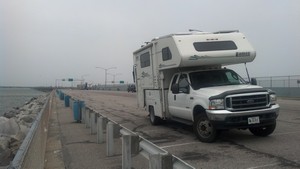 Leaving the Virginia mainland we drove the twenty miles of the Chesapeake Bay Bridge-Tunnel
a day earlier than originally anticipated as the high winds of the approaching tropical storm were expected to result in the
road being closed within the next twelve hours. Approaching the tunnels requires an act of faith as from a distance, and unable
to see the entrances, the low trestle bridges simple vanish as though a section has plummeted into the bay. The sky was a heavy
grey, the clouds moving at quite a clip as we crossed in the dim early evening light. In the event of needing sustenance on
this long crossing there is a handy cafe and gift shop where we stopped to look out at the bay, watch the seagulls battling the
wind and buy a Virginia fridge magnet.
Leaving the Virginia mainland we drove the twenty miles of the Chesapeake Bay Bridge-Tunnel
a day earlier than originally anticipated as the high winds of the approaching tropical storm were expected to result in the
road being closed within the next twelve hours. Approaching the tunnels requires an act of faith as from a distance, and unable
to see the entrances, the low trestle bridges simple vanish as though a section has plummeted into the bay. The sky was a heavy
grey, the clouds moving at quite a clip as we crossed in the dim early evening light. In the event of needing sustenance on
this long crossing there is a handy cafe and gift shop where we stopped to look out at the bay, watch the seagulls battling the
wind and buy a Virginia fridge magnet.
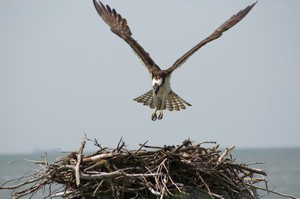 Our destination was Kiptopeke State Park, our arrival coinciding
with a serious downpour that continued till morning. Torrential daily rain has been a feature of much of June and the first
part of July and while precipitation figures for Lewis DE reveal that this is not the norm it is of little consolation:
June’s average is 3.4 inches while this year there has been 12.2, July’s average is 4.8, 4 of which had fallen by the 13th of
the month. Needless to say the ground is saturated and soft.
Our destination was Kiptopeke State Park, our arrival coinciding
with a serious downpour that continued till morning. Torrential daily rain has been a feature of much of June and the first
part of July and while precipitation figures for Lewis DE reveal that this is not the norm it is of little consolation:
June’s average is 3.4 inches while this year there has been 12.2, July’s average is 4.8, 4 of which had fallen by the 13th of
the month. Needless to say the ground is saturated and soft.
Very occasionally we come up against seemingly inexplicable rules in state parks along with truly stunning explanations given for their necessity. Kiptopeke’s campsite is in two distinct parts one with gravelled level parking pads in the woods, one on an open raised grassy area with no pads, many with a delightful gradient completely unsuited to RVs. Having arrived late we spent our first night on a site in the woods and walked up to the office the next morning to pay for the following days. It transpired that the sites in the woods, ideal for RVs were in fact designated tent only and we would have to move on to the grassy area. My polite querying of the rationale behind this summoned a ranger from his office who authoritatively pronounced it was because of “tenting issues”. Sterling and I looked at each other registering the disbelief on each other’s face and let it go, knowing we were beaten - until we got outside that is. Tenting issues? Tenting issues? What did it mean? Maybe the tents band together at night attacking unsuspecting RVs. We were stumped but then that is the effect of poorly explained regulations delivered in a no-nonsense, don’t question my authority tone. We’ll just never know. The unfortunate result was deep tyre ruts in the soft wet grass when we left.
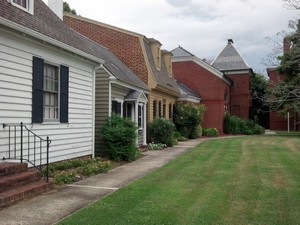 The peninsula has a uniformity that makes it difficult to distinguish between the three states. The occasional inland cities
are by and large surrounded by agricultural land dotted with sleepy backwater towns. The Delmarva has the dubious distinction
in our minds of being chicken slaughter capital of the world. Numerous battery chicken farms and huge meat processing plants
impart a delightful odor to the surrounding areas but running two shifts a day probably provide much needed employment in the
area. The coast boasts some monster tourist cities where Americans come to do their version of the British in Benidorm, but
obviously on their home soil. It’s not our thing but we drove through Ocean City, MD to take a peek and sure enough it’s side
by side hotels, motels, eateries and tack shops - the latter selling souvenirs in the worst possible taste which was our
motivation for the detour.
The peninsula has a uniformity that makes it difficult to distinguish between the three states. The occasional inland cities
are by and large surrounded by agricultural land dotted with sleepy backwater towns. The Delmarva has the dubious distinction
in our minds of being chicken slaughter capital of the world. Numerous battery chicken farms and huge meat processing plants
impart a delightful odor to the surrounding areas but running two shifts a day probably provide much needed employment in the
area. The coast boasts some monster tourist cities where Americans come to do their version of the British in Benidorm, but
obviously on their home soil. It’s not our thing but we drove through Ocean City, MD to take a peek and sure enough it’s side
by side hotels, motels, eateries and tack shops - the latter selling souvenirs in the worst possible taste which was our
motivation for the detour.
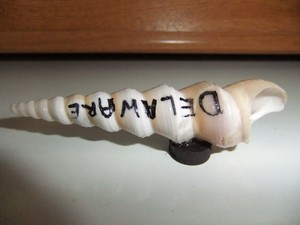 One of our sad habits while travelling has been to buy a fridge magnet from every state we visit. We have clear specifications:
they must have only the state name, must have imagery that somehow reflects our experience of the state and must be as tacky as
possible although we have weakened on occasion and bought one that might fall into a good taste category, if such a thing could
exist for fridge magnets. For reasons that we don’t understand, our quest has become much more difficult since coming east with
fewer and fewer magnets available. Having spent weeks in Virginia we finally managed to buy a somewhat unsatisfactory magnet at
the stop on the Chesapeake Bay Bridge Tunnel. In Maryland, in spite of many attempts we utterly failed to find a single magnet
and in an act of utter desperation we cheated and ordered one off the internet. In Delaware we cycled many miles before buying
the only available magnet we found in the entire state. As you may notice there is something intrinsically wrong with it
and not just the fact that it does little to represent the state. These difficulties have continued since leaving the peninsula:
In Rhode Island we bought a lapel pin and Sterling took the Dremel to it before glueing a magnet on the back. The nadir was
probably Connecticut where we resorted to hand writing the state name on a slice-of-watermelon magnet - things were desperate.
One of our sad habits while travelling has been to buy a fridge magnet from every state we visit. We have clear specifications:
they must have only the state name, must have imagery that somehow reflects our experience of the state and must be as tacky as
possible although we have weakened on occasion and bought one that might fall into a good taste category, if such a thing could
exist for fridge magnets. For reasons that we don’t understand, our quest has become much more difficult since coming east with
fewer and fewer magnets available. Having spent weeks in Virginia we finally managed to buy a somewhat unsatisfactory magnet at
the stop on the Chesapeake Bay Bridge Tunnel. In Maryland, in spite of many attempts we utterly failed to find a single magnet
and in an act of utter desperation we cheated and ordered one off the internet. In Delaware we cycled many miles before buying
the only available magnet we found in the entire state. As you may notice there is something intrinsically wrong with it
and not just the fact that it does little to represent the state. These difficulties have continued since leaving the peninsula:
In Rhode Island we bought a lapel pin and Sterling took the Dremel to it before glueing a magnet on the back. The nadir was
probably Connecticut where we resorted to hand writing the state name on a slice-of-watermelon magnet - things were desperate.
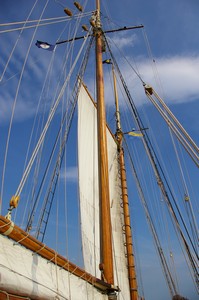 Many of the smaller places on the peninsula are obviously trying to be a little more upmarket than is usually required to find
good fridge magnets and Cape Charles, VA where we went for Sterling’s birthday, was no exception. A large village on the coast
it allows unregistered golf carts to drive on the roads and the many in evidence must help keep the carbon footprint of the town
in check. We had come for an afternoon cruise on a replica tall ship appropriately named The Virginia. As soon as volunteers were
requested to help hoist a sail, Sterling was on his feet looking as pleased as punch, heave-ho-ing with the rest. It was a bright
sunny afternoon and a wonderful few hours watching the workings of the crew, hearing the captain calling his orders and the
repeated echoes through the ranks, and looking at the intricate lines of the rigging and the patterns of rope coiled on deck.
The only downside was a lack of sufficient wind to justify the full complement of sails. We ate at a delightful pub called
Kelly’s Gingernut where Sterling had his photo taken in front of a retro poster advertising Snowdonia where we used to live.
As they say in Wales, Byd bach (Small world).
Many of the smaller places on the peninsula are obviously trying to be a little more upmarket than is usually required to find
good fridge magnets and Cape Charles, VA where we went for Sterling’s birthday, was no exception. A large village on the coast
it allows unregistered golf carts to drive on the roads and the many in evidence must help keep the carbon footprint of the town
in check. We had come for an afternoon cruise on a replica tall ship appropriately named The Virginia. As soon as volunteers were
requested to help hoist a sail, Sterling was on his feet looking as pleased as punch, heave-ho-ing with the rest. It was a bright
sunny afternoon and a wonderful few hours watching the workings of the crew, hearing the captain calling his orders and the
repeated echoes through the ranks, and looking at the intricate lines of the rigging and the patterns of rope coiled on deck.
The only downside was a lack of sufficient wind to justify the full complement of sails. We ate at a delightful pub called
Kelly’s Gingernut where Sterling had his photo taken in front of a retro poster advertising Snowdonia where we used to live.
As they say in Wales, Byd bach (Small world).
The following day, we crossed to the eastern side of the finger, to stay at Chincoteague for a couple of nights partly to cycle out to the southern unit of the Assateague Island National Seashore. A barrier island famous for its wild ponies, Assateague still shows the scars from recent hurricane Sandy with some areas remaining closed. It was a good ride, terns and skimmers evident down at the beach end and a herd of ponies directly in front of an information sign about ponies, presumably paid by the park service to stand in position.
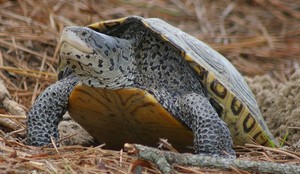 Arriving back at the campground we spotted a terrapin methodically digging a nest for her eggs. Tucked close to the base of a pine
on slightly higher ground, she moved the sandy soil with her large hind legs, so engrossed in her task that she let us approach
and watch. In half an hour, she dug the required hole, laid her eggs and covered them, patting the soil back into place and moving
pine needles over the site as camouflage. By the time she’d finished it was impossible to distinguish the site from the surrounding
area. Having completed her biological imperative, she slowly lumbered back towards the water disappearing through the tall grass.
Arriving back at the campground we spotted a terrapin methodically digging a nest for her eggs. Tucked close to the base of a pine
on slightly higher ground, she moved the sandy soil with her large hind legs, so engrossed in her task that she let us approach
and watch. In half an hour, she dug the required hole, laid her eggs and covered them, patting the soil back into place and moving
pine needles over the site as camouflage. By the time she’d finished it was impossible to distinguish the site from the surrounding
area. Having completed her biological imperative, she slowly lumbered back towards the water disappearing through the tall grass.
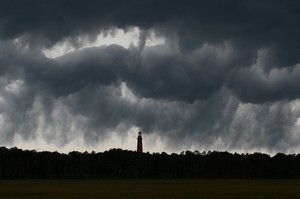 We were reminded of her journey the following afternoon as we watched a couple prepare to launch a kayak in one of the estuary
side creeks. They disappeared from sight and shortly afterwards the woman slowly re-emerged, largely covered in a thick black
mud that she attempted to wash off at a water stand. To be honest, she didn’t look that much better when she trudged back towards
the waters edge and set off through the tall grass looking for a way to reach her other half who had somehow managed to get the
kayak launched. As they finally paddled off, the sky started turning a particularly worrying shade as the cloud gathered ahead
of a serious storm. A severe thunderstorm warning arrived on the phone followed quickly by a tornado watch, the sky becoming more
threatening by the minute with amazing cloud formations building just to the east of us over Assateague. Hopefully the pair in the
kayak got to cover before the lightning started.
We were reminded of her journey the following afternoon as we watched a couple prepare to launch a kayak in one of the estuary
side creeks. They disappeared from sight and shortly afterwards the woman slowly re-emerged, largely covered in a thick black
mud that she attempted to wash off at a water stand. To be honest, she didn’t look that much better when she trudged back towards
the waters edge and set off through the tall grass looking for a way to reach her other half who had somehow managed to get the
kayak launched. As they finally paddled off, the sky started turning a particularly worrying shade as the cloud gathered ahead
of a serious storm. A severe thunderstorm warning arrived on the phone followed quickly by a tornado watch, the sky becoming more
threatening by the minute with amazing cloud formations building just to the east of us over Assateague. Hopefully the pair in the
kayak got to cover before the lightning started.
The northern unit of the Assateague Island National Seashore is on the other side of the state line in Maryland and we headed there for our next stop. The ocean side of the island is lined with beach and dunes, the remainder is an area of salt marsh, swamp and sandy woodland. The mosquitos here were as thick as any we’ve encountered since Florida with plenty of no see ums eager to take their share of the available buffet. Even with the use of the screen house and plenty of deet I resembled a strange polka dotted creature by the time we left.
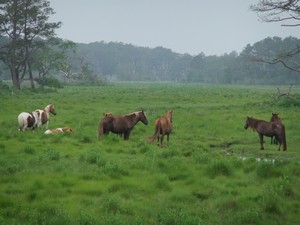 Warnings in the park about the wild ponies are fairly graphic with photographs of people who have been both bitten and kicked.
This is not to suggest that the ponies are dangerous when left to their own devices, only that they do not take kindly to people
getting too close. These warnings and the presence of “Pony Patrol” on both bicycles and golf carts seemed a little excessive to us
when we first arrived. When riding back into the park one afternoon we spotted cars stopped ahead of us and sure enough there on the
bike trail was a small group of ponies. We stopped a way off, waiting to see if they were going to move on by which time people were
out of their cars approaching the animals separated by only a few feet and a low single barred fence. More cars kept arriving, more
people approaching as we lifted the bikes over the barrier and cycled off up the road passing first Pony Patrol and then Ranger Bob
on their way to deal with the situation. Maybe the warnings need to be even more explicit.
Warnings in the park about the wild ponies are fairly graphic with photographs of people who have been both bitten and kicked.
This is not to suggest that the ponies are dangerous when left to their own devices, only that they do not take kindly to people
getting too close. These warnings and the presence of “Pony Patrol” on both bicycles and golf carts seemed a little excessive to us
when we first arrived. When riding back into the park one afternoon we spotted cars stopped ahead of us and sure enough there on the
bike trail was a small group of ponies. We stopped a way off, waiting to see if they were going to move on by which time people were
out of their cars approaching the animals separated by only a few feet and a low single barred fence. More cars kept arriving, more
people approaching as we lifted the bikes over the barrier and cycled off up the road passing first Pony Patrol and then Ranger Bob
on their way to deal with the situation. Maybe the warnings need to be even more explicit.
Delaware is another of what Sterling refers to as those nondescript little mid-Atlantic states and they do run together in the mind. Delaware stands out as somewhere not conducive to RV travel. There are towns such as Rehoboth that do not allow parking for vehicles longer than twenty feet, signs posted in town direct drivers of larger vehicles to contact the local police before attempting to park. In Lewes there was just a ban on RVs entering the town at all but fortunately we were on our bikes when we saw these notices.
 Hoping to leave the worst of the biting bugs behind we continued north to Cape Henlopen State Park in Delaware where the
temperatures soared into the mid-nineties. This is a campground without electricity and consequently there are few RVs in evidence.
Most people are tent camping and in spite of the temperatures they are determined to have the full experience including campfires.
Through the heat of the afternoon sun and into the evening, the smell of burning wood wafted through the campground while I
fantasized about snow, walk-in freezers and the Arctic. Sterling finally admitted that it was hot, which he is rarely willing to do
but of course qualified the admission with comments about humidity and dry climate.
Hoping to leave the worst of the biting bugs behind we continued north to Cape Henlopen State Park in Delaware where the
temperatures soared into the mid-nineties. This is a campground without electricity and consequently there are few RVs in evidence.
Most people are tent camping and in spite of the temperatures they are determined to have the full experience including campfires.
Through the heat of the afternoon sun and into the evening, the smell of burning wood wafted through the campground while I
fantasized about snow, walk-in freezers and the Arctic. Sterling finally admitted that it was hot, which he is rarely willing to do
but of course qualified the admission with comments about humidity and dry climate.